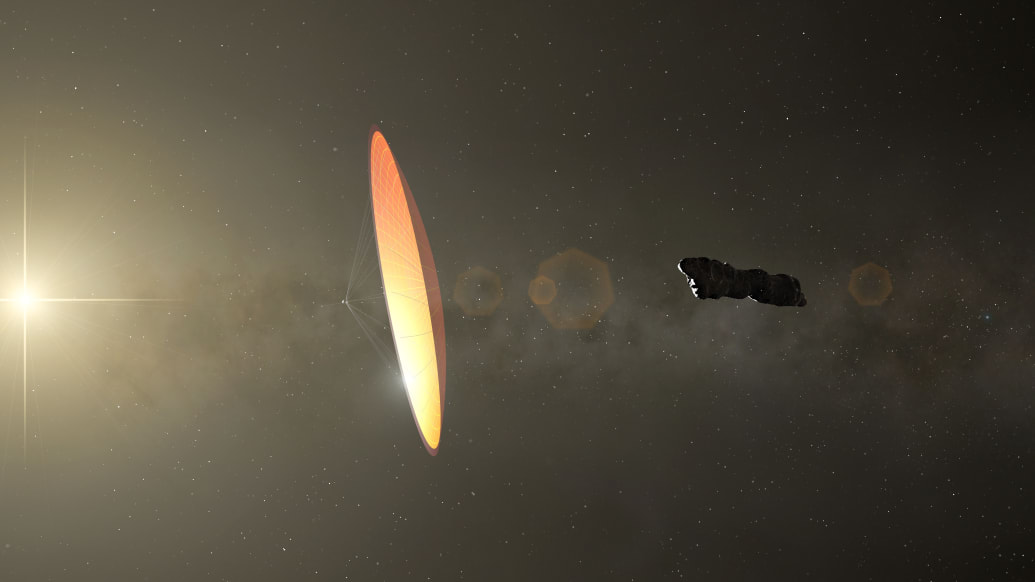Discovery & How Oumuamua Got It’s Name
The University of Hawaii’s Pan-STARRS1 telescope, funded by NASA’s Near-Earth Object Observations (NEOO) Program, found and tracked 1I/2017 U1 ‘Oumuamua, the first known interstellar object to visit our solar system, on Oct. 19, 2017. The object’s official name is P/2016 R3, but it has been nicknamed “Gerd,” which is German for “OUGHOUT.” It was discovered by the Pan-STARRS 1 telescope on May 19, 2016. The space rock passed within about 30 miles (48 kilometers) of Earth on September 9, 2017 at a speed of 196,000 mph (87.3 km/s), and its path triggered widespread interest. It was initially labeled a comet before it proved to not possess cometary activity after passing the Sun on September 9, 2017 at a breakneck speed of 196,000 mph (87.3 km/s). After being briefly classified as an asteroid because of new measurements that showed it was accelerating slightly, scientists have determined that it behaves more like a comet than an asteroid.
Artist’s concept of interstellar object1I/2017 U1 (‘Oumuamua) as it passed through the solar system after its discovery in October 2017. The aspect ratio of up to 10:1 is unlike that of any object seen in our own solar system. Image Credit: European Southern Observatory / M. Kornmesser
Overview
This interstellar visitor, the first confirmed object from another star to visit our planet, appears to be a rocky, cigar-shaped body with a somewhat pink tone. The alien is up to one-quarter mile long (400 meters) and highly elongated—perhaps 10 times as long as it is wide. Its aspect ratio is greater than any asteroid or comet observed in our solar system to date. Even though it has an elongated form, it differs from those seen in our solar system and may hold new insights into how other solar systems developed.
According to the data, this oddity had been roaming through our galaxy for hundreds of millions of years before coming into contact with our star system by chance.
“For decades we’ve theorized that such interstellar objects are out there, and now―for the first time―we have direct evidence they exist,” Thomas Zurbuchen, NASA’s Science Mission Directorate associate administrator in Washington, said in November 2017.
Immediately after its discovery, telescopes around the world, including ESO’s Very Large Telescope in Chile, were activated to measure the object’s orbit, brightness, and color. To obtain the most accurate data, ground-based telescope viewing was critical.
Karen Meech of the Institute for Astronomy in Hawaii and her colleagues used four different filters to combine the images from the FORS instrument on ESO’s telescope with those from other big telescopes to find that ‘Oumuamua varies in brightness by a factor of ten as it spins on its axis every 7.3 hours. No known asteroid or comet from our solar system varies so greatly in brightness, with such a large difference between length and width. The most stretched-out things we’ve seen to date are no more than three times longer than they are wide.
“This unusually big variation in brightness means that the object is highly elongated: about ten times as long as it is wide, with a complex, convoluted shape,” said Meech. “We also found that it had a reddish color, similar to objects in the outer solar system, and confirmed that it is completely inert, without the faintest hint of dust around it.”
READ MORE: Have Aliens Found Us? A Harvard Astronomer on the Mysterious Interstellar Object ‘Oumuamua
The object’s physical properties, such as its density and composition, suggest that it is dense, made of rock or metal, has no water or ice, and was reddened by the radiation impact of cosmic rays over hundreds of millions of years.
The fading object was tracked by a few huge terrestrial telescopes as it moved away from Earth. Two of NASA’s space telescopes, the Hubble and Spitzer, were used to track the object traveling at about 85,700 mph (38.3 kilometers per second) with respect to the Sun. The object is on an outbound path 20 degrees above the plane of planets orbiting the Sun. It passed Mars’ orbit around Nov. 1 and will pass Jupiter’s orbit in May 2018.’Oumuamua will travel beyond Saturn’s orbit in January 2019; as it leaves our solar system, it will head for the constellation Pegasus.
READ MORE: Ahoy! ‘Oumuamua may be a hydrogen iceberg
The object came from the vicinity of the brilliant star Vega in the northern constellation of Lyra, according to preliminary orbital computations. Even though the interstellar object took a long time to travel at around 59,000 miles per hour (26.4 kilometers per second), Vega was not in that position when the ‘Oumuamua was there about 300,000 years ago.
READ MORE: Why One Harvard Astronomer Believes This Asteroid Is an Alien Ship
Astronomers believe that an interstellar object similar to ‘Oumuamua passes through the inner solar system once per year, but they are faint and difficult to detect, and until now they have been missed. It is only in recent years that survey telescopes such as Pan-STARRS1 were powerful enough to find them.
“What a fascinating discovery this is!” said Paul Chodas, manager of the Center for Near-Earth Object Studies at NASA’s Jet Propulsion Laboratory, Pasadena, California. “It’s a strange visitor from a faraway star system, shaped like nothing we’ve ever seen in our own solar system neighborhood.”
How Oumuamua Got its Name
The International Astronomical Union (IAU), which is in charge of assigning official names to celestial bodies, officially named the object 1I/2017 U1. In addition to the technical name, the Pan-STARRS team gave it a Hawaiian name meaning “a messenger from afar arriving first,” called it “Oumuamua.”

